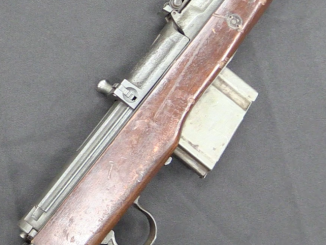The Madsen LMG was first introduced in 1902, and it is still in use with police forces in Brazil today. The Madsen was not very popular with major European armies, but it sold extensively in South America, with Brazil acquiring batches in 1932, 1935, and 1949. These were converted to 7.62mm NATO in the 1950s, and the military kept them in inventory until 1996. At that point they were given to the police, in particular the Rio de Janeiro state police. There, they were put to use providing cover and supporting fire for officers with M16 and FAL rifles. The sound of a Madsen firing bursts apparently has a substantial moral impact on the drug gangs that have made the Rio favelas a virtual war zone.
Video clips from Brazil came from these two videos:
To see much more on-the-spot footage from Brazilian police forces, check out FactualRJ:
https://www.youtube.com/@FactualRJ



So, what happened to all of the mags? These fill the same role as an HCAR, but it’d be nice to be able to reload them.
So in this modern day, they fulfil the intent of the original intent of such weapons in the early 21st Century, as a “Machine Rifle.
The following from my book, may be of interest;
No 1,100 NATAL BORDER REGIMENT.
NOTE : Friend Addison. Born 21st December, 1848, Kent, came to Natal 1849, as part of the fraudulent Byrne migration scheme. Sugar Planter and Miller, established at Addington, one of the first Sugar Mills in Natal; from 1894 he had a plantation at Stanger. He served at times in the Stanger Mounted Rifles, the ‘Natal Border Regiment’ sic, and the Natal Mounted Rifles, Lt Col Commanding 31st May, 1888, and subsequently their first Colonel. Served, Zulu War, The South African War, and other conflicts. Died Durban, 27th August 1924, buried Herwen, New Guelderland, Natal.
He is historically significant in a minor way, bringing to Natal from London for the 1906 Natal Rebellion, eight Rexer Automatic Machine Guns (a unlicensed British manufactured copy of the Danish Madsen Light Machine Gun (LMG) designed by two Danish citizens) for use by the Natal Militia regiments. Purchased for 80 pounds each by Natal citizens resident in London, the first use of a tactical man portable machine gun or LMG in any British Commonwealth service (firing 450 rounds per minute, complex and difficult to use), see Zululand Mounted Rifles. Subsequently they in service in GSWA, and then in German East Africa, where two Rexer guns were with Lt J.Arnott’s Machine Gun Section (of four Maxim Machine Guns) in May 1916, with the 1st Battalion, Cape Corps.(Capt I.D. Difford, The Story of the 1st Battalion Cape Corps (1915-1919)).
A article, Hamish Paterson, of the South African National Museum of Military History. The Natal Rebellion 1906-Some Military Perspectives. SAMHS Military History Journal Volume 13 No 5, June 2006, incorrectly states that 27 Rexers were used in the campaign and one of the causes of the heavy Zulu casualties. Court records in the UK show that at the closure of the Rexer Arms Company of London (extant 1906-11) manufacturing facility in 1908, due to a well known patents case, in total eight .303in guns had been sold to the Natal citizens, 27 to Mexico in 7mm, and six .303in and 44 7mm were in stock, with component parts for a substantial number of weapons without calibre. A further eight guns were purchased from the Receiver by the Natal Government, presumably the six in .303in, and a further two assembled from parts. Apart from their one successful use by the Zululand Mounted Rifles, their late appearance on the battlefield did not allow in any form their tactical development, their complexity for operational use, added to the fact they only had two 28 round magazines each (and slow to reload, using a mechanical device), makes it is very doubtful whether they a major factor in the end of the Rebellion, let alone a cause of heavy Zulu casualties.
Whilst the Madsen remained in production to the late 1950’s, purchased by many countries, notably in Asia, South America and Eastern Europe, it was always a very complex, and expensive weapon.”
Weapons that I have seen over the years, including some of the last manufactured in 7.62mm NATO, differ greatly. I examined a Rexer in the South African Infantry School Museum, comparing it with a Madsen LMG taken from the defeated German Colonial Army in the now Namibia, in 1915. In quality of manufacture, the Rexer distinctly superior to the Madsen.
A comparison between two captured weapons in Borneo in 1964, from the Indonesia Army, had a Royal Netherlands East Indies Army in 7.92mm, manufactured in 1930’s, and a 1957 Madsen in US 30.06, showed distinctive differences in manufacture and materials. The Royal Australian Infantry Corps Museum has a 1944 captured Madsen in 7.92mm from the Japanese in Bougainville in 1944, is a pretty poor quality weapon. When we examined it in 1973, its markings were recorded as being in Japanese characters, in fact they Chinese. Subsequent research saw it identified as a Chinese “Warlord” bootleg copy from the 1920’s.
Whilst Danish manufacture finished in 1959, there remained huge quantities of components. These assembled into weapons (in various calibres)in the 1960’s.
Whilst never fired one, the weapon in my mind appeared inferior to the Lewis Gun. And as for it being sold in opposition to the Czech ZB-26, or FN Browning Automatic Rifles, I have often wondered why? They are so patently superior as a infantry combat weapon. And as seen in this article still in use with Brazilian militarised police?